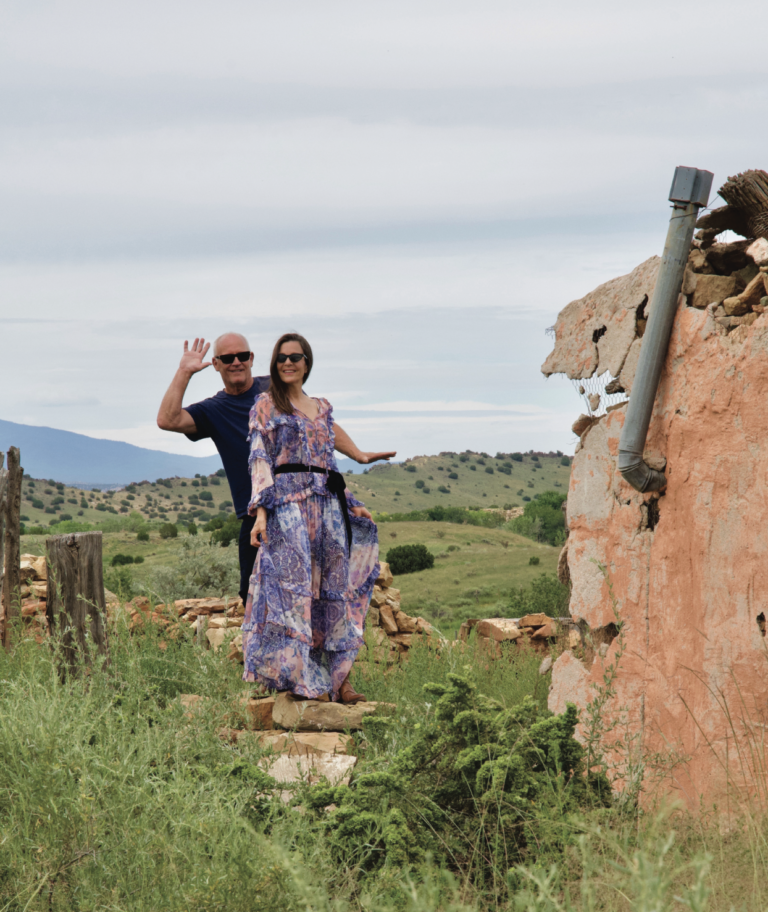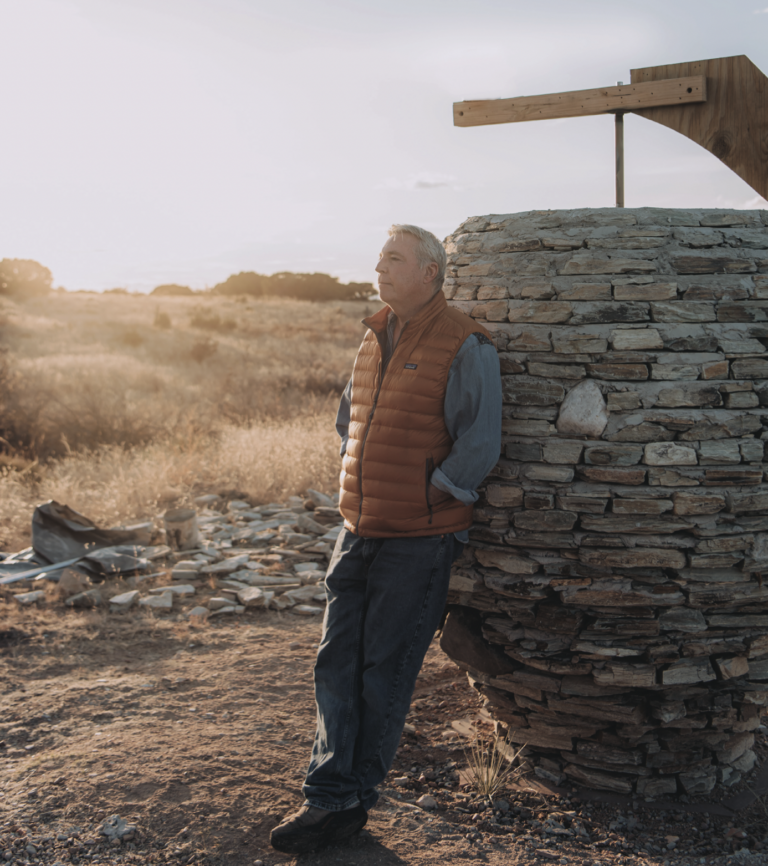TO FISH WITH TONER IS TO SEE JUST HOW INTIMATE he is with the trout. They are like friends or friends of friends who he checks in with regularly, removing them from their favorite watering hole and then, being a little apologetic for the inconvenience, releasing them back. I watched as he fished a stream so narrow that it could easily be mistaken for a running ditch, except it was not, as evidenced by the fact that he caught a large number of trout. This is all accomplished with a Zen-like comfort and skill, pulling the rod back as if it were a bow and releasing the fly as if it were an arrow.
By observation and immersion in rivers, he has become a recognized expert in water conservation and larger environment issues. Fully cognizant of the implacable climate challenges that lie before us, he is able to stay focused on doing what he can to make a difference in New Mexico.
Like cutthroat trout. This small, native New Mexican fish turns this taciturn, usually shy man into a passionate evangelist on the subject. He desperately wants them to survive and stay healthy. I am converted.
What is it about catching a fish that you love?
With me, it’s more about catching trout. I think they’re inevitably beautiful. Trout are just spectacular beings.
How so?
Just the way they’re constructed. Their colors, their faces, the way they’re built. It struck me at an early age. I began fishing when I was about eight. That was after seeing a few trout when I was six and seven years old. I knew that I wanted to see them a lot.
Do you feel their intelligence, their sovereignty?
I have the advantage of being able to reflect back over decades of fishing and looking at a lot of trout, and there’s always something new that reveals itself.
But what I keep going back to is it’s an animal that can’t exist unless certain conditions are met. There’s cold water involved, there are trees involved, there are mountains and snow involved. And there’s the water temperature. Then, the movement of water is a whole other story because it’s such a fascinating thing to contemplate, especially where trout are involved and how they look at currents and how they inhabit them or avoid them. So trout exist when these conditions are absolutely ideal. Those are pretty special occasions when the conditions are just right for trout being able to exist.
But I have been skeptical for decades, about the whole idea of trout being smart. They’re just super-duper keyed into their environment. There’s an evolution of hundreds of thousands of years involved in making this creature that wouldn’t exist if it had no ability to detect predation.
Trout have a line running down the sides of their bodies that can detect strange vibrations, which cause a fear response. They see certain things. I don’t know why they would see my dog or a cow and not spook, but they see me, a two-legged predator that they’ve undoubtedly seen throughout their evolution, and they spook. And they spook at a bird shadow flying overhead. I do like playing the game with trout where I am trying to avoid that fear response.
When you say you try to avoid the fear response, how do you do that?
You try not to make vibrations in the water. You try to not appear in their vision. Or if you do, you’re moving so slowly so as not to cause them to think anything’s different in their environment. You wear the right clothes, the right colors, you hide in shadows, you hide behind trees and rocks and things like that. It’s a fun game.
And part of that fun is, can I fool this evolved creature into thinking that fly is real?
Fooling a trout with a fly is not necessarily the objective. Why I keep coming back to it is that the predator is trying to blend into the natural environment so the trout thinks absolutely nothing is wrong with rising up and eating an artificial fly. The whole thing comes down to the game. The fly needs to be drifting at the speed of the current, otherwise the fish doesn’t recognize it as food. The fly needs to approximate a real insect, and the person needs to be as invisible as possible.
If a fish has been caught and released, does it remember?
I don’t know for sure. I know, or it’s been my experience, that going through enough of those catch and release experiences might make them a little pickier in terms of the type of imitation they’ll eat. Younger trout are easier to catch than older trout for the reasons we might suspect. Essentially wisdom.
So you’re talking about very evolved creatures and knowledge is implicitly passed on from trout to trout.
Right. And as they get old, they rise up in the hierarchy of the trout community.
There’s a hierarchy in the trout community?
If two trout are competing for a feeding station, the larger one will move the smaller one out and get better access to the food supply and thus grow even larger. When it comes to hiding places, the larger fish will move a smaller fish out of the hiding place.
You mentioned that water temperature is important?
Fishing is best between 50 and 65 degrees. You can catch fish above 65, but if you put a fish under stress at that temperature, you’re risking harming it. Also food supply is usually dependent on good quality of water. Good quality of water will enable a diversity of insect species to live and trout are mainly insectivores. In New Mexico, you want bank-side vegetation. That’s where things like ants, beetles, and grasshoppers live.
What’s life in New Mexico if you’re a trout?
If you’re a trout in New Mexico, you probably live above 7,000 feet elevation. In lower places, you encounter a lot of muddy water, due to human influence over centuries. If you’re a trout in muddy water, you’re impaired because you can’t see and trout are very visually oriented. However, they also have a very sensitive nose. They can feed by smell. All fish have what’s called a lateral line running down the side of their bodies. And that’s why sharks can detect vibrations in the water and move toward them. Trout have that same ability.
Also, there aren’t a lot of people in New Mexico or a lot of fishermen relative to other places. And, uniquely, we have lots of very, very small streams. They’re usually covered with overhanging vegetation like willow or alder trees, and that makes fishing for them very difficult. So if you’re a trout living in New Mexico, you might even be able to spend your whole life without being harassed because you live in a place that’s impossible for a human being to fish.
What are the good rivers to fish in New Mexico?
My favorite river to fish in New Mexico is the Rio Grande in the Gorge. My second favorite river to fish in New Mexico is the Chama. And the Los Pinos River up by the Colorado border. New Mexicans consider the Conejos River in Southern Colorado to be ours because the population of Santa Fe is the closest large population to the Conejos anywhere.
You say that if you’re serious about fishing in New Mexico, you have to fly fish as opposed to spin-cast.
Fly fishing is tailor made for New Mexico, given how many small streams there are. You can’t just walk up to a stream and throw something in. There’s a good amount of negotiation that’s required. You have to weave your way through vegetation and hopefully get some sort of hook into where the fish are. Obviously, the classic fly fishing back and forth doesn’t work for most New Mexico streams.
The other thing about New Mexico’s small streams is they’re shallow. So if you were to use a spinner, it sinks to the bottom, hooks on the bottom, and then you’re chasing it. Then when you go to get your spinner out, you spook every fish in the area.
We associate fly fishing with elitism, some waspy guy out fishing. What about that cliche?
Fly fishing was indeed an elite sport; I think we have to be honest about that.
If you look at history, especially in the UK, fishing was a sport of leisure, and they would have a lot of snobby regulations.
In America, there were a lot of people that were working too hard for too little money, who didn’t have the time to pursue a leisure activity. And the upper crust industrialist capitalist had time. They had the freedom to go and produce a leisure activity. But now flyfishing is much more of an egalitarian pursuit in New Mexico. In a lot of these rural communities, we have to remember that catching fish was not only for fun, it was for feeding families.
With your role at Trout Unlimited, you are trying to make sure that the conditions in which you can catch fish are safeguarded. Is that right?
Trout Unlimited is devoted to the health of rivers and cold water fisheries in general. We have two native species of trout in New Mexico, everything else is invasive. In Northern New Mexico, it’s the Rio Grande cutthroat trout, a distinct subspecies native to the Rio Grande drainage. We also have the Gila trout. Rio Grande cutthroat trout is priority one. Priority two is trout in general, which includes naturalized trout, like brown trout, and in some cases brook trout. We don’t address hatchery trout.
What are you working on lately?
What I’m seeing in my work lately is creating a habitat that is so rich and diverse that brown trout and cutthroat trout can coexist. And most of the time, this can be achieved through beaver habitat, simply expanding the amount of stream miles occupied by beavers.
Your grandfather was a lawyer. How did you get into this versus a job where you’d fish on weekends?
That part sucks for me, actually! I’d be much better off if I was a lawyer or a doc. I’d be free to go to Alaska whenever I wanted to if I had a career that was better compensated. But I’m serious when I say that I love trout more than I love fishing for them.
In my ten year career with Trout Unlimited, I came to realize that the native Rio Grande cutthroat trout is just breathtakingly beautiful — and it’s all ours. It’s all in the Rio Grande drainage. There is nowhere else where it exists.
And it occupies only ten percent of its ancestral habitat. As we become more urbanized, a lot of these populations are getting more remote. You used to be able to get in your car and drive from Santa Fe and catch Rio Grande cutthroat trout right off the road. You could occasionally do it in the Pecos. You could go up to Peñasco and catch Rio Grande cutthroat trout all day. You could do it up in certain streams in Taos. You could catch Rio Grande cutthroat trout all day right off the road. Now you have to do a backpack trip.
So the odds just stack against that. It’s almost a battleground feeling for me where having trout is a surrogate for any other native plant or animal being able to continue to persist in its own environment. That hits very close to home.
Home being my heart, home being New Mexico. I’m less passionate about catching trout than I am to know that they’re going to exist there when I’m gone. That is the real source of my passion. I’m a trout geek. I’m an absolute trout geek.
Learn more at TU.org
Photo SFM








